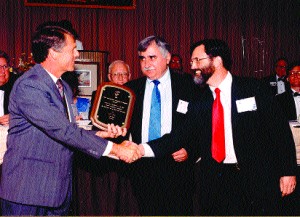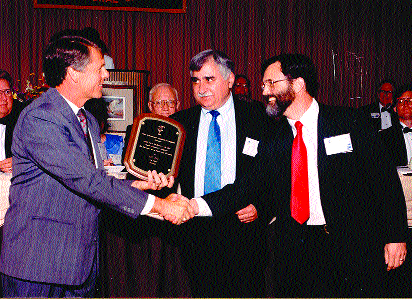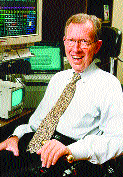By Mike Pincher

Joseph Lahoud, president of LC Technologies (middle), with Dixon Cleveland of LCT (to his right), accepts an award for Eyegaze technology.
NASA and commerce have collaborated again, with “eye-popping” results! Aiming to aid disabled persons in both personal and working environments, Congress funded NASA in 1998 to enhance eye tracker technology, targeting reduced size and portability.
Accordingly, NASA’s Jet Propulsion Lab in Pasadena, Calif., and LC Technologies, Inc. of Fairfax, Va., collaborated to greatly improve LCT’s Eyegaze Communication System.
It’s called Eyegaze because that is all the user needs to prompt a 15-inch monitor screen to perform such functions as typing, telephoning, speech synthesis, controlling lights and appliances, accessing the Internet and e-mail and using Microsoft Windows software.
The user sits about two feet from the screen, which has an infrared sensitive camera attached below that determines where the user is looking (his “gazepoint”) from one of his eyes with a one-quarter inch accuracy using a pupil-center/corneal reflection method. The user only needs to gaze at the appropriate screen monitor keyboard pad for about a half a second to prompt its function. The system also works for people wearing glasses or contact lenses.
“Initially, JPL worked with LC Technologies to miniaturize the camera and to make Eyegaze less sensitive to infrared light, such as sunlight and regular incandescent bulbs with light fixtures,” said Joseph Lahoud, president/CEO of LCT, which has been in business since July 31, 1986.
The NASA-LCT connection reduced the system’s weight by a factor of six with almost equal reduction in volume. It can now be mounted on a wheelchair. Even power requirements were reduced by a factor of four, with increased efficiency in the camera detecting eye movement. The impact of the system on education has been worldwide, allowing even those afflicted with muscular dystrophy and cerebral palsy to interact with students and teachers and to perform research and writing. From a labor standpoint, adults with brain injuries, multiple sclerosis, strokes and ALS (Lou Gehrig’s disease) are now employable and can even perform word processing.
Success stories abound, as evidenced at Eyegaze’s website, [http://www.eyegaze.com]. Joe Martin, retired bank president, has published two books using the system—”On Any Given Day” (his personal account of his ALS dealings) and “Fire in the Rock” (a novel set in the 1950s South).
Philippe Vigand (locked-in syndrome from a stroke) and wife Stephane of Paris, France, co-authored the book “Only the Eyes Say Yes” (“Putain de Silence”). Philippe’s contribution was made via Eyegaze. Its success is self-evident, having been widely distributed in 14 countries and translated into 11 languages.
“We have several children who started with their Eyegaze systems in grade school who are now going to college using their systems,” Lahoud further noted.
These and other disabled persons have demonstrated time and again that when they are given a more level playing field, their disability does not mean inability.
LCT has garnered its share of recognition for its Eyegaze work, including the 2002 Commonwealth of Virginia Department of Defense SBIR Phase I Outstanding Achievement Award; the 1991 Expert Merit Award from the International Trade Association; the 1990 New Product Award from the Virginia Society of Engineers; and the 1989 Product of the Year Award from the Fairfax Chamber of Commerce. Lahoud received a singular honor in 1993 for his Eyegaze contributions when he was given an American Express Platinum Leader award.
LCT coordinates with educational systems whenever possible and in ways transcending assisting pupils with debilitating physical disabilities.
“We have an ongoing project here, headed by James Chapman, M.D., to diagnose reading problems, and eventually to help to re-mediate those readers with help from the computer,” said Lahoud. “When they stop on a word they can’t read, the computer will say it for them.”
How can interested parents get their children exposed to the system?
“In the disability market,” Lahoud explains, “Medicare, Medicaid, private insurance companies and several schools have purchased systems. A parent can get an Eyegaze Communication System made a part of their child’s IEP (Individual Education Plan), so the school or state funds can help pay for it.”
Eyegaze technology has further potential in other settings.
“The Eyegaze technology has the potential to be used any place that a computer keyboard is used,” Lahoud pointed out. “The military is interested for pilots who already have both hands and feet busy. The Department of Transportation is interested in the potential of identifying a ‘drowsy driver,’ before he falls asleep at the wheel. People who suffer from carpal tunnel syndrome could type without further damaging their wrists.”
There are two distinct products connected with the Eyegaze Technology: the Eyegaze Communication System as discussed above and the Eyegaze Development System.
“We make the Eyegaze Development System for people who are doing R&D work and the Eyegaze Communication System for people with disabilities,” Lahoud said. “Both use the basic Eyegaze technology, but the disability system keeps track of your eye and causes things to happen. The R&D system keeps track of your eye and saves that information for you to look at later, such as in the reading application.”
For more information, visit [http://www.eyegaze.com]. LC Technologies can be reached at (800) 393-4293, by fax at (703) 385-7137 or by e-mail at requests@eyegaze.com.












